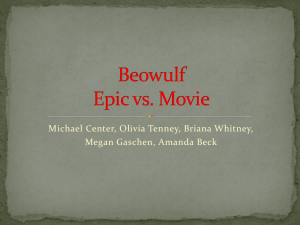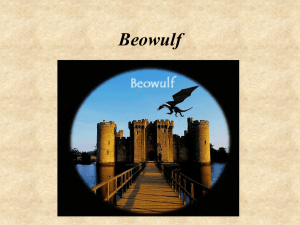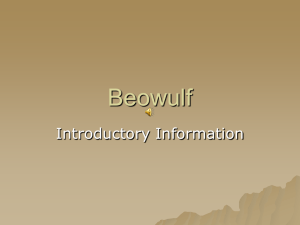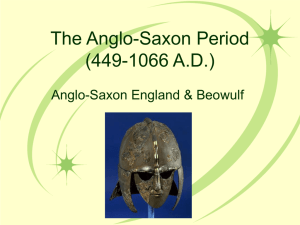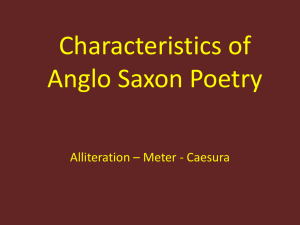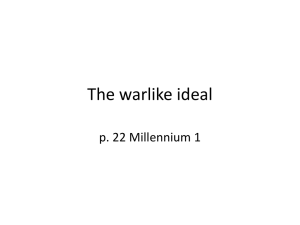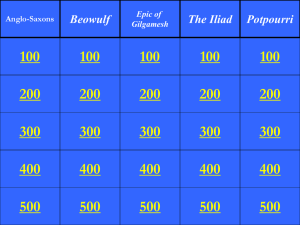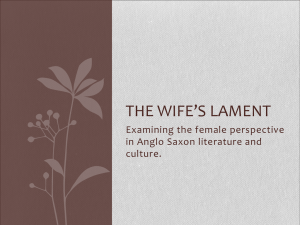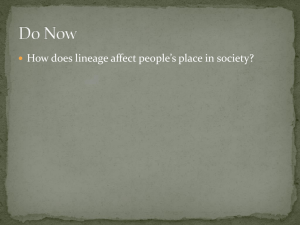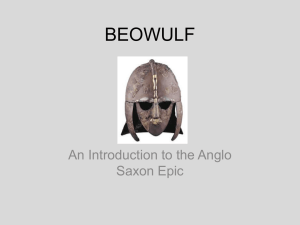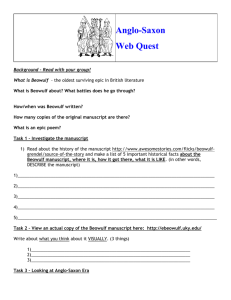Anglo Saxon & Beowulf Notes
advertisement
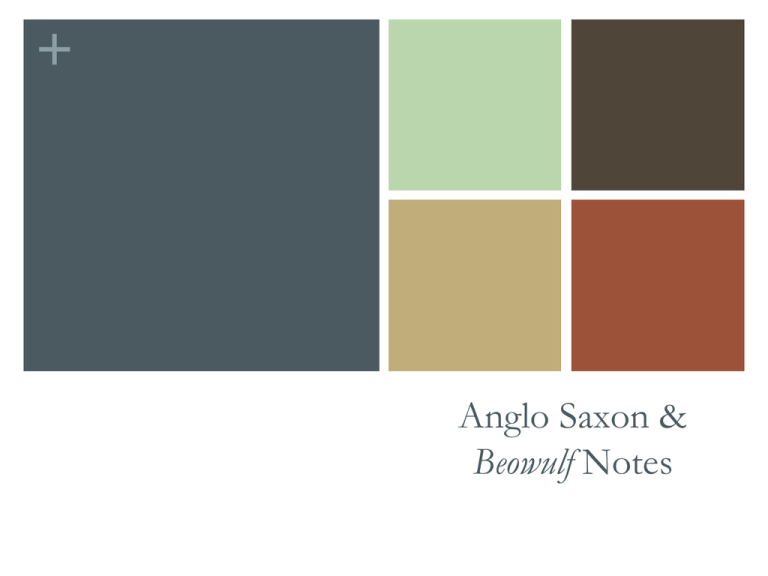
+ Anglo Saxon & Beowulf Notes + Anglo-Saxon England (449-1066) In the 5th and 6th centuries, Britain was invaded and conquered by Germanic tribes – the Angles, the Saxons, and the Jutes – collectively know as the Anglo-Saxons. The Anglo-Saxons was a tribal society, ruled by a warrior king and his fighting men who had sworn oaths to defend their leader. In return, the leader rewarded their service with gifts of treasure, usually captured from their enemies. The society centered around the king’s quarters and its main structure, the mead hall. Here, the king and his men would feast, drink mead, listen to the music and poems of a scop, and boast of their fame. The warriors would often sleep in the mead hall, as much from drunken exhaustion as from habit. + Anglo-Saxon Ideals: As a group, the Anglo-Saxons valued military discipline self-denial loyalty + The characteristics of their society were as follows: They valued personal liberty. They understood the responsibility of leadership. They loved adventure, fought hard, and scorned danger. + The Coming of Christianity The Anglo-Saxons were pagan until the end of the 6th century. In 597, Pope Gregory the Great sent Augustine to convert King Aethelbert of Kent, one of the greatest Anglo-Saxon kings. During the next 40 years, missionaries were able to convert most of the kings and their people to Christianity. The coming of Christianity seemed to offer more hope than the AngloSaxon view of life, which was compared to the flight of a bird, from darkness into a brightly lit hall, then back into darkness. + Anglo-Saxon Language and Literature English is divided into three periods: Old English (ca. 449-1100), Middle English (ca. 1100-1500), and Modern English (ca. 1500-). While many people think of Shakespeare's English as old, Shakespeare wrote and spoke Modern English, albeit, an early form of it. Chaucer's poetry, including his most famous work, The Canterbury Tales, are a good examples of Middle English poetry. Beowulf, which probably dates to some time between 700 – 1000 CE, is an Old English poem. Old English is sometimes known as Anglo- Saxon. The language of the Anglo-Saxons, though a forerunner to Modern English, in unrecognizable as English. Old English is a Germanic tongue, and it sounds harsh to the modern ear. Sample of Old English Text: + HWÆT, WE GAR-DEna in geardagum, þeodcyninga þrym gefrunon, hu ða æþelingas ellen fremedon! oft Scyld Scefing sceaþena þreatum, monegum mægþum meodosetla ofteah, egsode eorlas, syððanærest wearð feasceaft funden; he þæs frofre gebad, weox under wolcnum weorðmyndum þah, oð þæt him æghwylc ymbsittendra ofer hronrade hyran scolde, gomban gyldan; þæt wæs god cyning! http://www.beowulftranslations.net/beorefs/b eowulf-audio-0791a-0819a-benslade.mp3 + Anglo-Saxon Lang. & Lit. cont.: The poetry of the Anglo-Saxons is known for 5 characteristics: ① a love of adventure ② a sense of the importance of honor ③ an awe of natural beauty ④ a delight in word-play ⑤ an underlying sense of melancholy for the times gone by + The Structure of Beowulf Beowulf is an EPIC POEM, believed to be written in the early 8th century by a single, unknown author. Prior to being written, the story was passed down orally by bards/scops. While the poem is pagan in subject, its transcriber added Christian elements to it. Characteristics of an Epic: Hero – legendary, heroic, important nationally or internationally Setting – vast; covering great nations, the world, or the universe Action – deeds of great valor, requiring superhuman strength or courage Supernatural – gods, demons, angels, monsters intervene in action Style – elevated and simple Objectivity – hero’s deeds are told without moralizing + Conventions of the Epic Opens with a statement of the theme Invokes a muse or guiding spirit Often begins “in media res” (in the middle of things), then flashes back Includes catalogues of armies, warriors, ships, etc. Makes extensive use of the epic simile Main characters give extended formal speeches + Beowulf Beowulf is divided into 3 parts: ① An introduction ② The adventures of his young life ③ The adventure that finally kills him Beowulf fights 3 monsters: ① Grendel – a tall, hairy monster with tremendous strength ② Grendel’s mother – lives underwater, has hideous strength and poisonous blood ③ A dragon – fire-breathing beats that overcomes the aged hero + Important Names & Characters: Hrothgar – King of the Danes Herot – Hrothgar’s new mead hall Grendel – a monster; descendant of Cain Beowulf – famous Geat warrior Higlac – Beowulf ’s uncle and king Danes – inhabitants of Denmark Geats – inhabitants of Sweden Beowulf cont. Beowulf ’s Characteristics: Great strength Great courage + Intelligence Love of battle Graciousness + Anglo-Saxon Themes / Principles in Beowulf: Fate (wyrd) cannot be avoided. In order to survive, a man needs strength, courage, and intelligence. Humans want 2 types of immortality: Some type of afterlife To be remembered by future generations + Beowulf cont.: Christian Elements: Pagan Elements: Lines 21-29: Grendel’s origins Lines 64-72: need for revenge Lines 85-86: Grendel’s gracelessness Lines 85-96: Pagan sacrifice Lines 149-160: boasting Lines 174-175: God’s providence + Literary Terms: Kenning: a specialized metaphor made up of compound words or phrases. Examples: “sea stallion,” “wolf of wounds,” “shepherd of evil,” “guardian of crime” Caesura: a pause or break in a line of poetry Alliteration: repetition of initial consonant sounds at the in words close to one another
